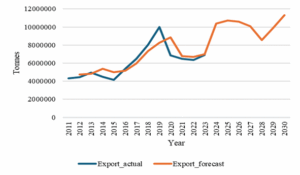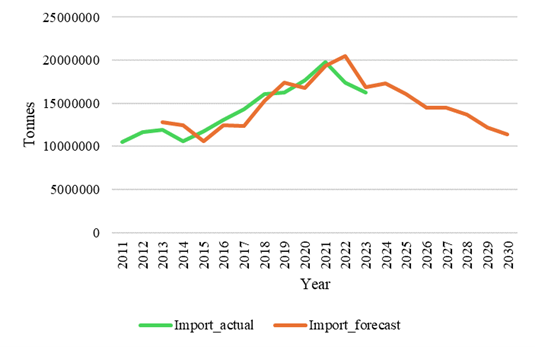By Seth KRAMPAH
Ghana’s import volumes are projected to decline, falling below 1.5 million tonnes by 2030, a study by the Center for Applied Research and Innovation in Supply Chain – Africa- (CARISCA) has revealed.
Meanwhile, export traffic is expected to rise, reaching approximately 1.2 million tonnes over the same period, signaling a major shift in the country’s trade dynamics.
This study explores the relationship between tax policies and port operations in Ghana, focusing on how changes in tax regimes affect port traffic and government revenue.
The trade forecast, based on trends reveals diverging outlooks for Ghana’s import and export activities. Historical data from 2011 to 2022 show that import volumes generally rose, with a notable surge beginning in 2013. Imports peaked at approximately 2 million tonnes in 2021 and 2022, a high point likely driven by post-pandemic recovery and heightened demand for goods.
However, the outlook from 2023 onwards paints a more cautious picture. The forecast shows a consistent downward trend, with import volumes expected to dip below 1.5 million tonnes by 2030.
This anticipated decline is attributed to a combination of factors, including rising import costs, the elimination of the Benchmark Value Discount Policy (BVDP), the Ghanaian Cedi’s persistent underperformance against major currencies, and a potential increase in local production reducing reliance on imported goods.

“This downward trend in import volumes signals a shift that both government and industry players must respond to. We are entering a phase where Ghana will need to lean more on domestic capacity and export-led strategies,” the report noted.
On the other hand, the export forecast offers a more optimistic outlook. From 2011 to 2019, export volumes steadily grew, reaching about 1 million tonnes by 2019. The period from 2020 to 2022, however, was marked by fluctuations likely stemming from global supply chain disruptions during the COVID-19 pandemic.
Looking forward, export traffic is forecast to rise sharply, notably in the previous year 2024, when volumes are expected to increase exponentially before stabilizing in subsequent years.
According to the report, the projected rise in exports by 2030 to approximately 1.2 million tonnes could be driven by improved global demand, coupled with enhanced domestic production capabilities, as data suggest.
However, the report caution that this upward trend will be sustainable only if Ghana implements favorable trade and industrial policies.
“The export sector’s growth potential is real, but it won’t reach its full promise without intentional investment in infrastructure, trade facilitation, and policy consistency,” the report stated.
The diverging paths of imports and exports call for adjustment of Ghana’s trade and economic strategies. Policymakers are urged to capitalize on the promising export outlook while mitigating the factors driving the import decline. This includes supporting value-added manufacturing, reducing barriers to export markets, and stabilizing the macroeconomic environment to encourage investment.
This reflects the potential for Ghana to capitalize on its export sector if favorable policies are implemented, the report added.










